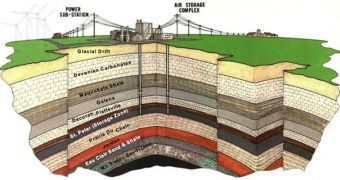Using wind farms for electricity production is one of the most environmentally-friendly methods of obtaining electricity nowadays. This industry really took off over the past couple of decades, with engineers designing ever larger and more efficient propeller blades and turbines. But occupying vast areas with these instruments is unfeasible, considering that the land cannot be used for anything else after that. Now, a new idea shows that wind production could be moved underground, in disused mines and other similar facilities, Wired reports.
Efforts to combine the power of compressed air with wind turbines are currently underway in the Midwest, but these companies are not the first to make such attempts. A technology such as the one proposed now has been functioning since 1991, but the trend did not catch on at the time. Over the years, technological means have progressed considerably, and now we have the capabilities required to actually make such daring plans work, experts say. In the underground, air constantly moves around, but the main issue is that it does not do so steadily. If these intermittent motions can be converted into ordered ones, than coal could see its final days as the main source of heat for electricity production.
In the case of compressed-air energy storage plants, the basic operating principle is rather simple. Air is being pumped inside large, sealed chambers, in large amounts. This allows for the inside of the room to experience high air pressures. The concept is similar to the one that drives a compressed spring after it's finally released. The amount of energy that is put into bending the spring in the first place is then released to a great extent. A similar approach has also been made in the case of compressed-air power plants. The extra wind would be pumped in huge underground caverns, and then it would be released to drive turbines whenever needed.
“This is the first non-hydro renewable technology that can replace coal in the dispatch order,” explains General Compression co-founder David Marcus. The company was recently awarded no less than $16 million from a series of investors, in order to construct a large-scale energy storage system. The groups funding this investigation, which also included the utility company Duke Energy, believe that the company's proprietary design could indeed work. It calls for introducing arrays of wind turbines at the locations, and putting them to work under a steady supply of air.

 14 DAY TRIAL //
14 DAY TRIAL //